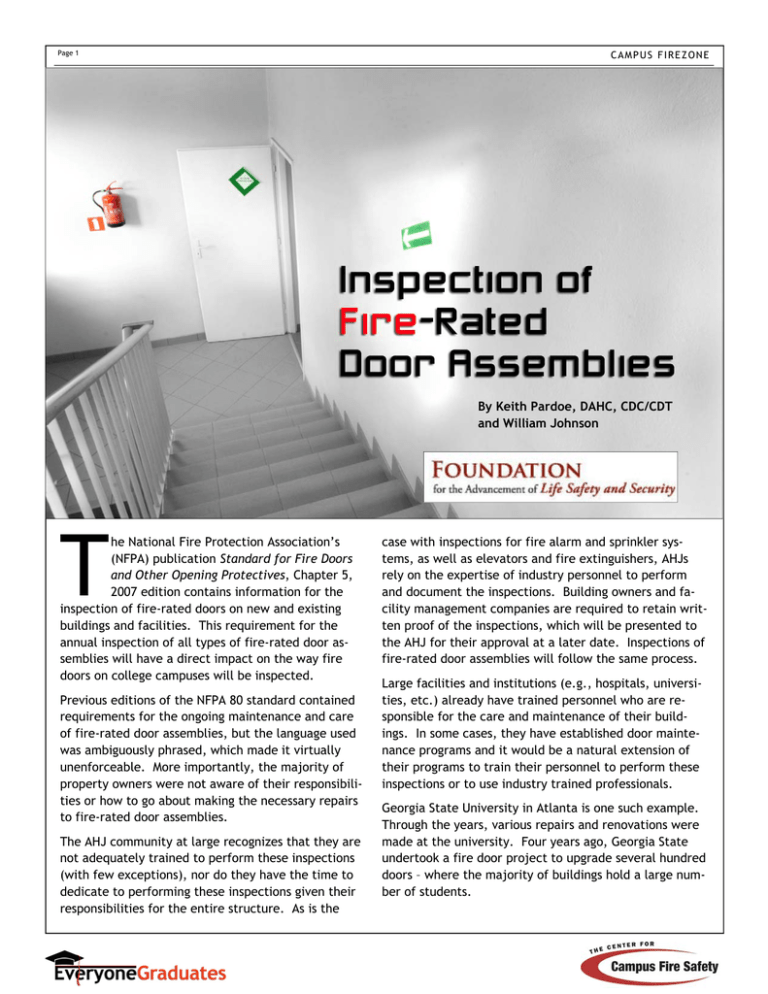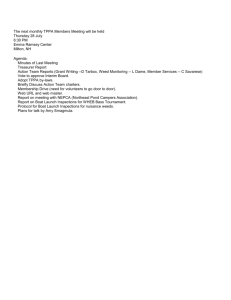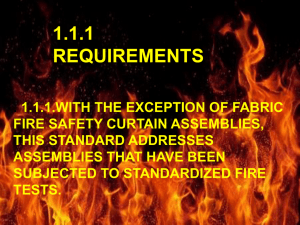T
advertisement

Page 1 CAMPUS FIREZONE By Keith Pardoe, DAHC, CDC/CDT and William Johnson T he National Fire Protection Association’s (NFPA) publication Standard for Fire Doors and Other Opening Protectives, Chapter 5, 2007 edition contains information for the inspection of fire-rated doors on new and existing buildings and facilities. This requirement for the annual inspection of all types of fire-rated door assemblies will have a direct impact on the way fire doors on college campuses will be inspected. Previous editions of the NFPA 80 standard contained requirements for the ongoing maintenance and care of fire-rated door assemblies, but the language used was ambiguously phrased, which made it virtually unenforceable. More importantly, the majority of property owners were not aware of their responsibilities or how to go about making the necessary repairs to fire-rated door assemblies. The AHJ community at large recognizes that they are not adequately trained to perform these inspections (with few exceptions), nor do they have the time to dedicate to performing these inspections given their responsibilities for the entire structure. As is the case with inspections for fire alarm and sprinkler systems, as well as elevators and fire extinguishers, AHJs rely on the expertise of industry personnel to perform and document the inspections. Building owners and facility management companies are required to retain written proof of the inspections, which will be presented to the AHJ for their approval at a later date. Inspections of fire-rated door assemblies will follow the same process. Large facilities and institutions (e.g., hospitals, universities, etc.) already have trained personnel who are responsible for the care and maintenance of their buildings. In some cases, they have established door maintenance programs and it would be a natural extension of their programs to train their personnel to perform these inspections or to use industry trained professionals. Georgia State University in Atlanta is one such example. Through the years, various repairs and renovations were made at the university. Four years ago, Georgia State undertook a fire door project to upgrade several hundred doors – where the majority of buildings hold a large number of students. Page 2 University officials were keenly aware of the level of trust parents and family members place in them to provide the highest level of safety in the buildings there children occupy on a daily basis. With this responsibility and the certainty of the inspection requirement in the not too distant future, Georgia State decided to move ahead as soon as possible with the inspection of fire doors. As a first step toward this goal, a certified inspector begin inspecting the doors and recording details on their condition. Since funding would not allow them to cover all the fire doors at once, the university first concentrated on the doors of greatest importance in case of an actual fire – for example, stairwell doors and main lobby doors. The certified inspector and his team inspected about 170 doors in five university buildings. They performed operational tests, took photos, checked the labels, recorded the kind of hinges and other hardware, and noted the overall condition of the door and its hardware. With knowledge of the most recent code changes, Georgia State implemented the provision for rolling inspections – called the Performance-based Option -which allowed them to inspect one-third of the doors each year, provided good records were properly maintained. This, in essence, creates a three-year inspection cycle for the end user. When Georgia State’s process is completed, their record keeping will allow the fire marshal or Authority Having Jurisdiction (AHJ) to determine the condition of each door, and verify that it was properly inspected by a knowledgeable individual, along with any corrective actions that were, or need to be, taken. The building owner is ultimately the responsible party for making sure the inspections take place and that the fire-rated door assemblies are properly maintained. The role of the inspector is to simply record and report the condition of the door assemblies to the owner. The owner will have to decide if, when, and what corrective actions will be taken; otherwise, they will run the risk of being cited for violations by the AHJ. Understand, inspectors are not passing or failing door assemblies, nor are they approving them. Only the AHJ has the authority to approve, in this case, the door assemblies and building elements within their jurisdiction. The inspector is simply reporting the condition of the door on the day it was inspected. CAMPUS FIREZONE It is important to remember that NFPA 80 is a product standard, not a code. As such, NFPA 80 establishes the minimal level of quality for the products used to create fire-rated door assemblies and their installation. Consequently, NFPA 80 requires individuals performing the inspections of fire-rated door assemblies to be knowledgeable of the types of assemblies being inspected. However, it does not attempt to define what constitutes an acceptable level of knowledge (e.g., experience, training, certification, etc.) for these individuals. Instead, NFPA 80 relies on the Authority Having Jurisdiction (AHJ) to determine if the individuals performing inspections in their region have the requisite level of knowledge to perform these safety inspections. The majority of fire-rated door assemblies are classified as swinging doors with builders hardware (see chapter 6 of NFPA 80), which can also be the most complex type of fire-rated door assemblies due to their locations within buildings and facilities. In addition to their fireprotection properties, these door assemblies often provide accessibility, life-safety and security functions, which can increase their complexity dramatically. Inspectors have to be extremely knowledgeable of a broad range of products that can, and cannot, be used on these types of openings; this depth of knowledge can only be gained through experience. Another frequently raised issue regarding the inspection of swinging doors with builders hardware concerns the number of existing openings and the high number of possible product combinations used to create them. The sheer number of possibilities makes inspections both overwhelming and virtually unenforceable. It is certainly true that the number of installed fire-rated swinging doors with builders hardware is extremely large and growing every year. Modern day assemblies have different capabilities and limitations than yesterday’s assemblies. However, when you look at the criteria for inspecting them (see section 5.2.4 of NFPA 80), you will see the base elements are the lowest common denominator that all of these assemblies must meet. It will take some time for these inspections to be universally required across the country. As with other significant changes in regards to inspections, fire door inspections will ramp up slowly as AHJs and their respective jurisdictions adopt the 2007 edition of NFPA 80 and its inspection requirements. Remember, NFPA 80 does not require the inspections to be performed by third-party inspectors, nor does it require professional certification for the inspectors; only that the inspectors are Page 3 CAMPUS FIREZONE knowledgeable about the types of openings being inspected. While certification is not a requirement of NFPA 80, the training and certification process provide the attendee with the necessary knowledge to facilitate the inspections. This standard is coming and we are already seeing it enforced in locations around the country. Some locations are enforcing the inspections because it is now part of their code, others because they know it needs to be done from a life safety perspective. Whatever the reason, know that the tools are in place to help your campus successfully implement a fire-door inspection program. In order to increase the awareness among college and universities and AHJs, the Foundation for the Advancement of Life Safety and Security and The Center for Campus Fire Safety are exploring the feasibility of jointly conducting half-day training sessions that will provide an attendee with the ability to understand what has been inspected and what should or should not be approved. If you are interested in perhaps hosting one of these training programs at your campus, please contact us at: support@campusfiresafety.org For more information on the Foundation or on DHI’s certified training program, please call 703-222-2010 or email Bill Johnson at bjohnson@dhi.org. ________________________ Keith Pardoe is the Director of Education at the Door and Hardware Institute. William Johnson is the Executive Vice-President of the Foundation for the Advancement of Life Safety and Security. Also contributing to this article was Marty Waterfill, Facility Engineer at Georgia State University. DHI 34th Annual Conference & Exposition, September 16 - 25, 2009, Orlando, FL Registration is now more affordable than ever! Register today to take advantage of these exciting events: Forum for the Future Conference Education Sessions Industry Marketplace Exposition Hall & Receptions on the Show Floor MORE INFO





